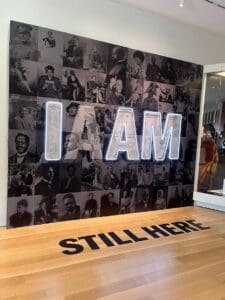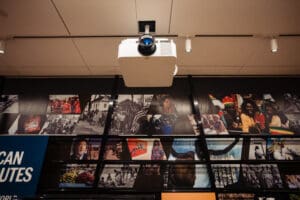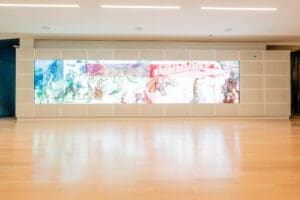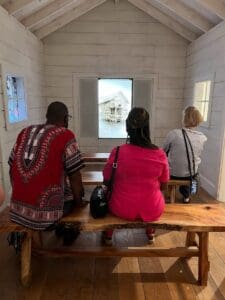International African American Museum (IAAM), which recently opened its doors, honors the difficult and often untold stories of the African American journey. It is located in Charleston, South Carolina, on Gadsden’s Wharf, one of America’s most sacred international slave trading ports. IAAM uses technology, including that of Sony, to combine storytelling and history while providing heightened engagement, communication and education.
With support from Sony’s Global Social Justice Fund — which champions social justice and anti-racist initiatives and fosters diversity, equity and inclusion around the world — technologies from Sony helped IAAM visitors engage with history and bring artifacts to life. Some of these included the Crystal LED direct view displays, professional 4K HDR BRAVIA displays, 4K SXRD and 1080p laser projectors, and professional wireless audio and mics.
According to Sony, the technology also serves to expand upon the stories introduced in the museum, which intends to help heal and facilitate a larger dialogue about our cultures and pasts.
Designing an Interactive, Multi-Platform Experience
 The IAAM thus deliberately designed and programmed an interactive, multi-platform experience for today’s digital natives, who have a high standard for technology and a desire to connect with stories in multi-faceted, multi-sensory ways – inside and outside the facility. The museum also sought technology that would amplify the experiences of the African American journey in a manner that would deepen the narrative and provide added levels of connection, immersion and reality.
The IAAM thus deliberately designed and programmed an interactive, multi-platform experience for today’s digital natives, who have a high standard for technology and a desire to connect with stories in multi-faceted, multi-sensory ways – inside and outside the facility. The museum also sought technology that would amplify the experiences of the African American journey in a manner that would deepen the narrative and provide added levels of connection, immersion and reality.
Dr. Tonya M. Matthews, president and chief executive officer of IAAM says, “Every good museum will focus on the stories and the storytelling. I think for an African American History Museum in particular, there’s added weight and added excitement when African Americans get to tell their own story because for so long that wasn’t what we saw in museums. I’m very excited about the way that the museum is using technology to activate and to enhance these stories. It’s an integral part of who the IAAM is.”
As Malika Pryor, chief learning and engagement officer, explains, “We are a museum that has been designed to share and we’ve embraced the idea of curating beyond our walls. As a new museum, we’ve leaned into technology as a way to really communicate — to deepen or to broaden the story in a way that makes it feel much more real.”
Technology as Focal Point
 Technology is a focal point of the IAAM visitor experience. Pryor notes, “When someone’s walking into the exhibition space for the first time, they come into contact with the Transatlantic Experience. I refer to that as this grounding moment for the visitor because what they’re going to see in these eight screens before them is this immersive visual and sonic experience that gives them a really firm grasp of what it is that they’re going to see as they’re moving through the other exhibitions and installations.”
Technology is a focal point of the IAAM visitor experience. Pryor notes, “When someone’s walking into the exhibition space for the first time, they come into contact with the Transatlantic Experience. I refer to that as this grounding moment for the visitor because what they’re going to see in these eight screens before them is this immersive visual and sonic experience that gives them a really firm grasp of what it is that they’re going to see as they’re moving through the other exhibitions and installations.”
The eight massive 6-foot-wide-by-7-foot tall screens that welcome visitors to IAAM are Sony Crystal LED displays. These display incorporate beneficial features for a museum, including high brightness, a wide viewing angle and anti-reflection panels. The displays also feature rotating content including a mix of powerful historical and modern imagery and photography that highlights and juxtaposes the African and African American experience.
Dr. Matthews elaborates, saying “When you first walk in the doors, you have this wonderful sense of being surrounded by all these still and moving visual images and music as these eight panels serve as a guiding hallway in our Transatlantic Experiences gallery. Then, you flow into the Atlantic World’s Gallery which I can assure you has one of the biggest screens you have ever seen inside of a museum, which allows us to immerse folks in visuals and sounds. This is one of my favorite galleries because it deliberately mixes up artifacts and stories from across the African diaspora.”
Capturing the Stories and Emotions
In the Atlantic Worlds Gallery, Sony’s massive 32-foot-by-7-foot Crystal LED with 7,680 x 1,620 resolution serves as the centerpiece of the space. It overlooks an exceptional view of the Atlantic Ocean and Gadsden’ Wharf, the actual port of entry for slaves. Thus, it helps reclaim the location’s complex associations and turns it into a place of empowerment, education, conversation and understanding. As Dr. Matthews explains, “That power of place comes with power of activation.”
Bobby Teachey II, project manager, who worked with the Solomon Group to install and set up the AV equipment, inclusive of the enormous Crystal LED displays, describes their impact. “It’s amazing technology. When you look really closely at the modular cabinets, there’s actually even smaller LED modules inside of it. It was amazing to see it all come together and watch content presented on the displays.”
Teachey adds, “The scale of the screen in the Atlantic World’s Gallery and the definition of the graphics will connect people in a different way. And the vibrant colors and details such as sweat coming off of somebody’s head — there’s so much information and such powerful imagery that visitors are going to want to stand in front of it for a long time to catch all of the different stories.”
He elaborates, “Beyond the pictures, beyond the display cases, the technology is showing older photos or videos or re-enactments, providing a point of connection to bring artifacts to life.”
Delivering Transformative Experiences
Teachey also speaks of the Sony 4K HDR professional BRAVIA displays, of which more than two dozen ranging in size from 55 inches to 85 inches hang throughout IAAM as digital signage and to enhance exhibitory. This includes the models showcased in the replica Praise House — a place of worship for enslaved individuals.
“The way these high-definition screens are used within the Praise House is very impactful,” he says. “You’re watching a video on them but you’re inside a replica of a building that’s very ancient and solemn and the technology has a reverence and a purpose. It allows you to be transported back, so again it’s serving as a transformative piece that connects everyone to these stories.”
 In addition, IAAM uses Sony projectors, lenses and wireless audio solutions throughout its space. The projectors help screen content, support wall-mapped content and share footage in rotating exhibits and screening rooms, as well as in the IAAM’s Center for Family History, an important space for tracing genealogy and connecting the dots of people’s pasts.
In addition, IAAM uses Sony projectors, lenses and wireless audio solutions throughout its space. The projectors help screen content, support wall-mapped content and share footage in rotating exhibits and screening rooms, as well as in the IAAM’s Center for Family History, an important space for tracing genealogy and connecting the dots of people’s pasts.
Dr. Matthews also acknowledges technology’s ability to move the IAAM outside of their facility. She explains, “We also have virtual exhibitions which we launched before we opened our physical doors. This has allowed membership and interest to grow around the nation and the globe. Technology allows us to serve those who may not physically enter our space, through virtual exhibitions.”
Engaging with Digital-Native Audiences
 She maintains that technology from Sony enables the IAAM to engage with a more digitally savvy audience. “Digital natives have a high standard for technology and expect it to do more than just sit there. They expect technology to be used to engage them. They want to be a part of a story, they want to generate a story, they want to add to a story. As a history museum using technology, we are particularly positioned to be able to do that – to engage, to share stories, to capture stories, to receive stories and to build upon stories.”
She maintains that technology from Sony enables the IAAM to engage with a more digitally savvy audience. “Digital natives have a high standard for technology and expect it to do more than just sit there. They expect technology to be used to engage them. They want to be a part of a story, they want to generate a story, they want to add to a story. As a history museum using technology, we are particularly positioned to be able to do that – to engage, to share stories, to capture stories, to receive stories and to build upon stories.”
Sony’s support of the Museum, through the company’s Global Social Justice Fund, is also viewed as instrumental by their personnel. Dr. Matthews says, “For museums and businesses in the non-profit sector, what we’re trying to do is provide access. We are trying to deliver more than our community in and of itself can support. So, it’s really important to have corporate partners who understand that and are as equally committed as we are.”
She adds, “And I must give a nod to partners who lean into the more difficult stories, who lean into the impact of telling difficult stories well and who understand that the reason we’re sharing these stories and learning this history is not just about yesterday, but it’s about today and it’s about tomorrow.”
Teachey adds, “Sony being able to step up and provide a lot of the donated technology and expertise is massive.”
Emphasis on Social Justice and Diversity
 “As part of Sony’s ongoing commitment to social justice and diversity, we are proud to support the efforts of the International African American Museum to bring the important history and stories of the African American journey to life and help educate and inspire millions of people to create a more just, equitable and inclusive society,” shares Karen Kelso, vice president, corporate social responsibility and social impact, Sony Corporation of America.
“As part of Sony’s ongoing commitment to social justice and diversity, we are proud to support the efforts of the International African American Museum to bring the important history and stories of the African American journey to life and help educate and inspire millions of people to create a more just, equitable and inclusive society,” shares Karen Kelso, vice president, corporate social responsibility and social impact, Sony Corporation of America.
Overall, those at the IAAM all agree that their purpose is to provide visitors with a way to connect with, engage with and build upon their understanding of the past to help influence the future, and technology is pivotal in sharing these stories and bringing them to life.
Pryor sees the IAAM “not as a beginning, middle and end” and recognizes that the museum means different things to different people throughout their quest for knowledge. She continues, “Maybe we’re a part of someone’s beginning. Maybe we’re helping them flesh out their middle. But we never want to be the end.”
Dr. Matthews “hopes that visitors will leave the museum more curious than they came in.” Similarly, Teachey’s desire is that “you walk away with something that you did not come with.” He adds, “The biggest piece is walking away with conversations that help to connect and mend and mold and heal. The museum and its technology can bring all of that together for visitors.”
Click on “View Slideshow” for additional images of the IAAM.
All images courtesy of Sony. Photography by Greg Noire.









